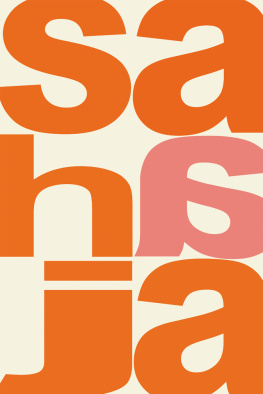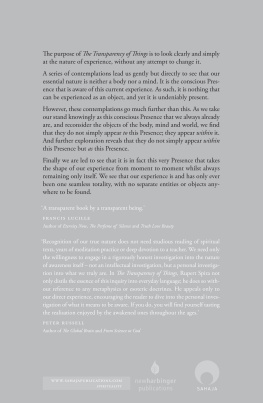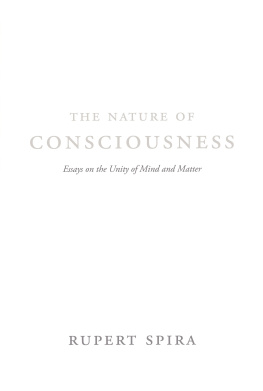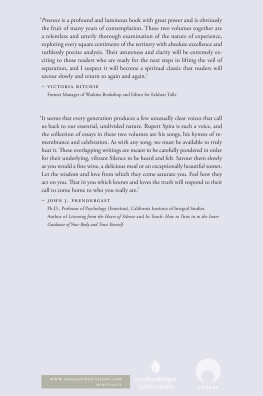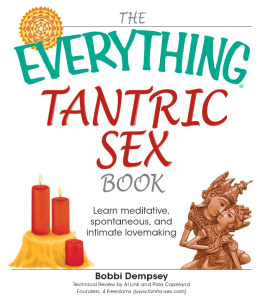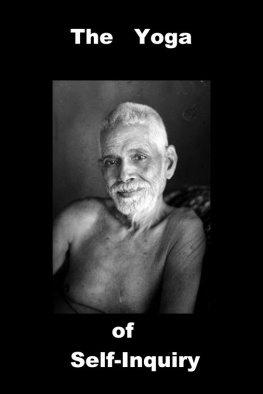Wide Ocean - sahaja: The Natural Way
Here you can read online Wide Ocean - sahaja: The Natural Way full text of the book (entire story) in english for free. Download pdf and epub, get meaning, cover and reviews about this ebook. year: 2019, publisher: BookBaby, genre: Religion. Description of the work, (preface) as well as reviews are available. Best literature library LitArk.com created for fans of good reading and offers a wide selection of genres:
Romance novel
Science fiction
Adventure
Detective
Science
History
Home and family
Prose
Art
Politics
Computer
Non-fiction
Religion
Business
Children
Humor
Choose a favorite category and find really read worthwhile books. Enjoy immersion in the world of imagination, feel the emotions of the characters or learn something new for yourself, make an fascinating discovery.
- Book:sahaja: The Natural Way
- Author:
- Publisher:BookBaby
- Genre:
- Year:2019
- Rating:4 / 5
- Favourites:Add to favourites
- Your mark:
- 80
- 1
- 2
- 3
- 4
- 5
sahaja: The Natural Way: summary, description and annotation
We offer to read an annotation, description, summary or preface (depends on what the author of the book "sahaja: The Natural Way" wrote himself). If you haven't found the necessary information about the book — write in the comments, we will try to find it.
Sahaja means that which is natural or spontaneous. Sahaja first found expression in India towards the end of the first millenium CE. It is a tantric approach to life and living, and to finding fulfulment in the midst of the vicissitudes of daily life.
sahaja: The Natural Way — read online for free the complete book (whole text) full work
Below is the text of the book, divided by pages. System saving the place of the last page read, allows you to conveniently read the book "sahaja: The Natural Way" online for free, without having to search again every time where you left off. Put a bookmark, and you can go to the page where you finished reading at any time.
Font size:
Interval:
Bookmark:
 To find out more about this book
To find out more about this book
including the paperback edition, please visit:
www.vividpublishing.com.au/sahaja Edited by Ian Wilson Copyright 2019 Wide Ocean ISBN: 978-1-925952-36-0 (ebook edition)
Published by Vivid Publishing
A division of Fontaine Publishing Group
P.O. Box 948, Fremantle
Western Australia 6959
www.vividpublishing.com.au Version 1.0. All rights reserved. No part of this publication may be reproduced, stored in a retrieval system or transmitted in any form or by any means, electronic, mechanical, photocopying, recording or otherwise, without the prior written permission of the copyright holder. In memory of Vimala Thakar with love.  Nairatmya Contents Preface To be alive is to be.
Nairatmya Contents Preface To be alive is to be.
In your hurry to be on your way elsewhere perhaps youve overlooked it? Have you noticed recently that you are alive? Maybe you have forgotten? Have you not noticed the smell of the first day of spring when it arrives and the play of dappled sunlight across the ground? Have you noticed just how unordinary the ordinary is? A lemon. A butterfly. The sound of rain drops on the roof. The sycamore tree. Bees buzzing madly around the lavender flowers. The dreamy drifting of the clouds across the sky.
The soft breeze on your face. Life is an unending mystery. Its a miracle of the impossible. It is a precious gift. Introduction The stanzas contained in this volume are derived from the verses attributed to the tantric adept Saraha who lived towards the end of the first millennium in northern India. As such, they disclose his teachings on the tantric path of sahaja.
What is sahaja? Sahaja is a kind of tantra. Tantra literally means warp and weft or tapestry. So, one might say that to engage in tantra (for there can be and is no tantra in abstraction) means to spin or to weave. However just as there is no one pattern of a carpet and there is no one way to spin fabric, there is no one tantra. In fact, there are many tantras, and they all adopt quite different patterns and methods of weaving. So as a tantra, sahaja is a particular kind of weaving.
Its not just any weaving. Its a very particular way of spinning the rough cloth of unexamined life into the most beautiful cloth of illumination. In short it is the tantra of weaving the energies of contracted existence into the energies of unconstriction and freedom. It is a particular approach to overcomin g the misconception that one is constricted or un-free through a process of dismantling the conventional and self-limiting way that one sees oneself and the world. Sahaja is also called the path of bliss-emptiness. Its called the path of bliss-emptiness because in sahaja the essence of mind is recognized as bliss-emptiness.
And so, in sahaja the experience of existence is woven into bliss, love, joy and delight. In terms of what this path of bliss-emptiness looks like, its hard to describe since the way of sahaja has no fixed outer form. There are no fixed rituals to follow, no chants and no supplications. There are no gods and no deities to bring fresh flowers to. There are no physical postures. There are no positions to be assumed.
Yet, on the other hand there might be if you are so inclined. In sahaja there are no hierarchies. There are no leaders and no followers. Yet there are always good friends you meet on the road who have journeyed further than you. There are no rules and no regulations. No vows.
There is no specific time to rise and no time to retire. And yet at the same time whatever is useful may freely be adopted for as long as it is useful. Thats because that which may be useful for you might be a hindrance to me. And what may be useful for me might be poison for you. Etymologically, sahaja means the innate or spontaneously arisen. It also means that which is natural.
So, the way of sahaja is the natural way. It is the way that flows freely and easily. It has no fixed outer form and it adheres to no rigid view of things. It is an inner journey of the heart-mind that is travelled within. It is the heart that determines what is to be done or not to be done. The path of sahaja is the natural path which means that for you it will be one thing and for me it will be something else.
In other words, the path of sahaja is the shoe that fits the foot. When the shoe fits the foot there is harmony. And in harmony there is balance. And so, you have a symphony of life. You have beauty. When the inner energies of the human being are in harmony and inner and outer merge into one wholeness, there is bliss and delight.
And when there is delight then there is love. Such is sahaja. Wide Ocean Summer 2019 The Text The primary verses of the text are very loosely derived from the Treasury of Couplets of Saraha written in the Western Apabhramsa language of north India. It should be emphasised that the verses as presented here are not intended in any way as either literal or scholarly renderings. Rather, they should be considered to be like a distant echo heard from afar by someone standing on the other side of the fjord of time. The Western Apabhramsa version of these verses was discovered in a Nepalese royal library in 1907 and was published by Haraprasad Sastri in 1916.
The actual text was never located as an independent manuscript. However, the verses correspond with the verses forming part of a commentary, the Dohakosa-Panjika by Advayavajra, an eleventh century Indian tantric theorist. Of Saraha himself, we know very little. He is mentioned as one of the siddhas in the Caturasits-siddha-pravrtti (T he Lives of the Eighty-Four Siddhas ) a collection of hagiographies composed by the eleventh century Indian scholar Abhayadattasri (the great teacher of Campara). He also features in the Carypada (performance songs) written in the old Bengali script. All we can really say however, is that he probably lived in north-east India, in Bengal or Orissa, sometime during the Pala and Sena dynasties (circa 750-1250CE), most likely during the ninth century based on the chronology of events contained in the Caturasits-siddha-pravrtti .
As to the Treasury of Couplets of Saraha we cannot say with any accuracy who composed them. In fact, we have no idea whether they were related to Saraha at all. They could have been composed by a later Sahaja tantric scholar and adept and attributed to the personage of Saraha. We will simply never know. Verses PART I: EMPTY SMOKE RINGS 1. Blowing Smoke into Your Own Eyes Those poor priests, theyre absolutely clueless! Pointlessly they recite a lot of mumbo jumbo.
They imagine that purity is found by bathing in holy rivers. They make offerings to the god of fire but its all just a case of blowing smoke into your own eyes! Commentary Saraha is pointing out that it is difficult to see things clearly when youve got smoke in your eyes. With smoke in your eyes, things appear to be other than as they are. In the Caryagiti , Saraha says: Misconception is most perplexing; it appears as the divided. But such imagination is as empty as a reflection in water. 2.
A Great Actor Then there are those who dress up like actors playing a part. Hes handsome and so charming. The ladies love him. Imagining that he is a great sage gratuitously he imparts some teachings. He cant see up from down, or back from front. Unfortunately he is totally lost himself hell just send you off in the wrong direction! Commentary In the Kularnava Tantra it is stated: Numerous are those who are bent on the improvement of their situation.
But one who is beyond all concern is hard to find. Be careful says Saraha. Truth is not for sale. And wisdom cannot be bought. The true teacher reveals the light whereas the false one stands in its way. 3.
Next pageFont size:
Interval:
Bookmark:
Similar books «sahaja: The Natural Way»
Look at similar books to sahaja: The Natural Way. We have selected literature similar in name and meaning in the hope of providing readers with more options to find new, interesting, not yet read works.
Discussion, reviews of the book sahaja: The Natural Way and just readers' own opinions. Leave your comments, write what you think about the work, its meaning or the main characters. Specify what exactly you liked and what you didn't like, and why you think so.

